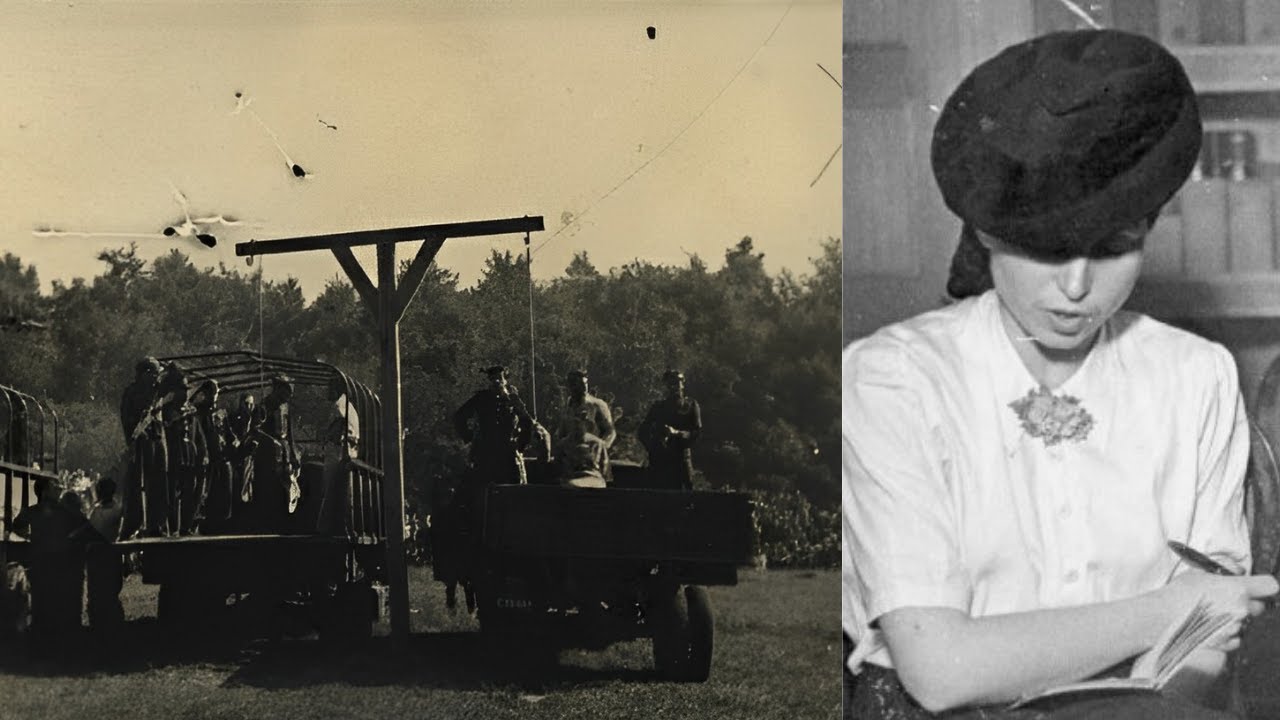
Who was Jenny Wanda Barkmann? Jenny Wanda Barkmann, born on May 30, 1922, in Hamburg, Germany, was a notorious overseer in Nazi concentration camps during World War II. Known for her brutal treatment of prisoners at the Stutthof camp, she earned the nickname "Beautiful Spectre" due to her cruel actions masked by her appearance. After the war, she fled but was eventually captured and tried for crimes against humanity. Her trial and public execution in 1946 serve as a grim reminder of the atrocities committed during the Holocaust. Barkmann's story is a chilling example of the depths of human cruelty.
Key Takeaways:
- Jenny Wanda Barkmann, a notorious figure in World War II, was involved in the Holocaust and faced public execution for her crimes, serving as a reminder of the importance of accountability in history.
- Her role as a female guard in Nazi concentration camps and her public execution highlight the significant involvement of women in the Holocaust, shedding light on the severity of her actions and the historical impact.
Early Life and Background
Jenny Wanda Barkmann's early years set the stage for her later actions during World War II. Understanding her background helps us grasp how she became involved in the atrocities of the Holocaust.
-
Birth and Early Life: Born on May 30, 1922, in Hamburg, Germany, Barkmann grew up during a time of significant political change.
-
Childhood: She spent her childhood in Hamburg, though specific details about her early life remain sparse.
-
Adolf Hitler and the Nazi Party: By age 10, Adolf Hitler and the Nazi Party had risen to power, influencing the environment in which she grew up.
-
World War II: At 17, World War II began, marking the start of a period that would see her involvement in Nazi concentration camps.
Role in the Holocaust
Barkmann's role in the Holocaust was marked by extreme cruelty and brutality. Her actions at the Stutthof concentration camp left a lasting impact on survivors.
-
Stutthof Concentration Camp: Established in 1939, Stutthof was where Barkmann would later serve as a guard.
-
Role as a Guard: In 1944, she became an Aufseherin (overseer) in the Stutthof SK-III women's subcamp, known for her brutal treatment of prisoners.
-
Brutality and Atrocities: Barkmann was infamous for selecting women and children for the gas chambers and other cruel acts, earning the nickname "Beautiful Spectre."
Capture and Trial
After the war, Barkmann's attempts to evade justice were short-lived. Her capture and subsequent trial highlighted the severity of her crimes.
-
Escape and Arrest: She fled Stutthof after the war but was arrested in May 1945 while hiding in Gdańsk.
-
Trial and Conviction: In 1946, Barkmann faced trial in the first Stutthof Trial, where she was found guilty of crimes against humanity.
-
Execution: Barkmann was publicly executed by short-drop hanging on July 4, 1946, along with 10 other defendants.
Public Execution and Aftermath
Barkmann's execution was a significant event, drawing a massive crowd and extensive media coverage. It served as a stark reminder of the consequences of her actions.
-
Public Execution Details: Approximately 200,000 people witnessed her execution, which was recorded by official press photographers.
-
Personal Appearance During Trial: Despite her crimes, Barkmann focused on her appearance during the trial, wearing stylish clothes and different hairstyles daily.
-
Behavior of Female Colleagues: Barkmann and her female colleagues behaved insolently during the trial, further outraging survivors.
-
Remorse and Final Statement: She showed no remorse, remarking, "Life is indeed a pleasure, and pleasures are usually short."
Historical Significance
Barkmann's case holds historical significance, not only for her role in the Holocaust but also for the public nature of her execution.
-
Historical Significance: Her case is notable for the public execution, one of only three such events in Poland after World War II.
-
Media Coverage: The execution received extensive media coverage, serving as a public display of justice.
-
Legacy and Impact: Barkmann remains a symbol of the atrocities committed during World War II and the importance of accountability.
Astrological Profile
While not scientifically proven, some have explored Barkmann's astrological profile to understand her personality traits.
-
Astrological Profile: An astrological profile includes her birth data and planetary dominants, though her birth time is unknown.
-
Astrological Dominants: Mercury in Gemini suggests intellect and social skills, though the analysis is limited without her birth time.
-
Horoscope and Chart: Born under the sign of Aries, associated with the head and governed by Mars, influencing her personality traits.
-
Personality Traits: Astrology suggests certain traits, but it should be noted that astrology is not scientifically proven.
Historical Popularity and Rankings
Barkmann's notoriety extends to her presence on Wikipedia and other historical records, reflecting her impact on history.
-
Historical Popularity: Her Wikipedia page has received over 831,161 views since 2007, available in 19 languages.
-
Rankings: Among mafiosos, she ranks 26th out of 70, and 1,530th among biographies from Germany.
-
Memorability Metrics: An HPI of 58.74 indicates significant memorability and impact on historical records.
-
Languages Editions: Her biography's availability in 19 languages reflects global recognition.
-
Effective Languages Coefficient: A coefficient of 5.60 indicates wide translation and accessibility.
-
Coefficient of Variation: A CV of 2.15 suggests consistent translation efforts across languages.
Contemporaries and Deceased in 1946
Barkmann's life and death are contextualized by her contemporaries and other notable figures who died in 1946.
-
Contemporaries: Among people born in 1922, she ranks 90th, with notable figures like Barbara Bel Geddes and Roger Etchegaray.
-
Deceased in 1946: Among those who died in 1946, she ranks 60th, alongside figures like Grigory Mikhaylovich Semyonov and Rüdiger von der Goltz.
Public Execution and Female Guards
Barkmann's execution and role as a female guard in Nazi concentration camps highlight the involvement of women in the Holocaust.
-
Publicly Executed People: Her case is unique due to the public nature and media coverage of her execution.
-
Female Guards in Nazi Concentration Camps: Barkmann exemplifies the role women played in perpetuating the Holocaust.
-
Female Mass Murderers: As a female mass murderer, her case is particularly egregious due to her gender and the severity of her crimes.
-
Filmed Executions: Her execution was one of the few filmed in history, providing a visual record.
-
Holocaust Perpetrators in Poland: Barkmann's actions took place in Poland, making her a significant figure in the history of Holocaust perpetrators there.
-
Stutthof Trials Executions: Her execution was part of the Stutthof trials, significant in bringing Nazi war criminals to justice after World War II.
The Legacy of Jenny Wanda Barkmann
Jenny Wanda Barkmann's life is a chilling reminder of the horrors of World War II. Born in Hamburg in 1922, she became an overseer at the Stutthof concentration camp, where her cruelty earned her the nickname "Beautiful Spectre." Her brutal actions, including selecting women and children for gas chambers, left a lasting impact on survivors. After the war, she fled but was eventually arrested and tried for crimes against humanity. Her public execution in 1946, witnessed by thousands, marked a significant moment in post-war justice. Barkmann's story serves as a stark example of the depths of human cruelty and the importance of accountability. Her actions and the subsequent trial highlight the need to remember and learn from history to prevent such atrocities from happening again. Her legacy is one of infamy, a dark chapter in the annals of human history.
Frequently Asked Questions
Was this page helpful?
Our commitment to delivering trustworthy and engaging content is at the heart of what we do. Each fact on our site is contributed by real users like you, bringing a wealth of diverse insights and information. To ensure the highest standards of accuracy and reliability, our dedicated editors meticulously review each submission. This process guarantees that the facts we share are not only fascinating but also credible. Trust in our commitment to quality and authenticity as you explore and learn with us.


